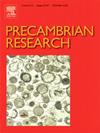Petrogenesis of 3.3–3.1 Ga granitoids in the Anshan continental nucleus, North China Craton: Implication for multi-stage magmas underplating processes
IF 3.2
2区 地球科学
Q2 GEOSCIENCES, MULTIDISCIPLINARY
引用次数: 0
Abstract
Archean tonalite-trondhjemite-granodiorite (TTG) suite and K-rich granitoids provide direct evidence of the generation and differentiation of the Archean continental crust. Within the North China Craton (NCC), the Anshan area serves as an exceptional natural laboratory, preserving a geological record spanning from 3.8 to 2.5 Ga. Here, we conducted comprehensive geochemical, geochronological, and zircon Hf–O isotopic analyses for the Paleoarchean–Mesoarchean granitoids from the Anshan region. Zircon U–Pb dating suggest that these granitoids formed during 3.3–3.1 Ga. The ca. 3.3 Ga monzogranitic gneisses exhibit high SiO2 and K2O, low Mg# values, negative Eu anomalies, unradiogenic Hf isotopes (i.e., εHf(t) values = -5.16–+0.08, TDM2 age = 4264–3729 Ma), and “mantle-like” δ18O values (up to + 5.64 ‰). Geochemical features divide them into two distinct groups, both are recycling products of pre-existing Eoarchean TTGs. Group 1 and Group 2 originated from 10 %–20 % and 20 %–30 % partial melting of pre-existing Eoarchean TTGs at depths of 1.25–1.75 GPa and 0.5–0.75 GPa, respectively. The ca. 3.3 Ga trondhjemite gneisses show high SiO2, low Mg# values, low Sr/Y and (La/Yb)N ratios. Their εHf(t) values range from + 0.91 to + 1.10, with TDM2 ages of 3682–3665 Ma. In contrast, the ca. 3.3 Ga monzonitic gneisses have lower SiO2 contents, higher Al2O3, total alkali (Na2O + K2O), and Sr/Y and (La/Yb)N ratios. Their εHf(t) values range from −2.69 to + 0.50, with TDM2 ages of 4040–3750 Ma. The ca. 3.1 Ga trondhjemite gneisses display higher Sr/Y and (La/Yb)N ratios, enriched LREEs and depleted HREEs. Magmatic zircons yield δ18O values of 3.87–6.52 ‰ and εHf(t) values of −2.39 to + 0.95, with TDM2 ages of 3881–3550 Ma. The geochemical and Hf-O isotope characteristics suggest that both the 3.3–3.1 Ga trondhjemite gneisses and the ca. 3.3 Ga monzonitic gneisses originated from partial melting of mafic rocks at variable depths. During 3.3–3.1 Ga, the NCC experienced intensive crustal growth and rework/recycling. Two magmatic events (ca. 3.3 Ga and ca. 3.1 Ga) and subsequent tectono-thermal events were induced by multi-stage magmatic underplating of mantle upwelling within a plume-related tectonic setting.
华北克拉通鞍山陆核3.3-3.1 Ga花岗岩类岩石成因:多期岩浆底板作用的启示
太古宙闪长花岗岩(TTG)套件和富钾花岗岩类为太古宙大陆地壳的生成和分异提供了直接证据。在华北克拉通(NCC)中,鞍山地区是一个特殊的自然实验室,保存了3.8 - 2.5 Ga的地质记录。本文对鞍山地区古太古代-中太古代花岗岩类进行了地球化学、年代学和锆石Hf-O同位素综合分析。锆石U-Pb测年表明这些花岗岩形成于3.3-3.1 Ga之间。约3.3 Ga二长花岗质片麻岩具有高SiO2、高K2O、低mg#值、负Eu异常、非放射性成因Hf同位素(εHf(t) = -5.16 ~ +0.08, TDM2年龄= 4264 ~ 3729 Ma)和“地幔样”δ18O值(高达+ 5.64‰)等特征。地球化学特征将它们划分为两个不同的类群,它们都是已存在的太古宙TTGs的再循环产物。第1组和第2组分别来源于1.25 ~ 1.75 GPa和0.5 ~ 0.75 GPa深度的原太古代ttg的10% ~ 20%和20% ~ 30%部分熔融。3.3 Ga长闪长片麻岩具有高SiO2、低mg#、低Sr/Y和(La/Yb)N的特征。它们的εHf(t)值为+ 0.91 ~ + 1.10,TDM2年龄为3682 ~ 3665 Ma。3.3 Ga二长岩片麻岩SiO2含量较低,Al2O3含量较高,总碱(Na2O + K2O)含量较高,Sr/Y和(La/Yb)N含量较高。它们的εHf(t)值在−2.69 ~ + 0.50之间,TDM2年龄为4040 ~ 3750 Ma。3.1 Ga长闪长片麻岩具有较高的Sr/Y和(La/Yb)N比值,lree富集,hree贫化。岩浆锆石δ18O值为3.87 ~ 6.52‰,εHf(t)值为−2.39 ~ + 0.95,TDM2年龄为3881 ~ 3550 Ma。地球化学特征和Hf-O同位素特征表明,3.3 ~ 3.1 Ga长闪长片麻岩和3.3 Ga二长长片麻岩均源于变深度基性岩的部分熔融作用。在3.3-3.1 Ga期间,北中陆块经历了剧烈的地壳生长和再加工/循环。约3.3 Ga和3.1 Ga两个岩浆事件及其后的构造-热事件是由地幔上升流的多期岩浆底沉降引起的。
本文章由计算机程序翻译,如有差异,请以英文原文为准。
求助全文
约1分钟内获得全文
求助全文
来源期刊

Precambrian Research
地学-地球科学综合
CiteScore
7.20
自引率
28.90%
发文量
325
审稿时长
12 months
期刊介绍:
Precambrian Research publishes studies on all aspects of the early stages of the composition, structure and evolution of the Earth and its planetary neighbours. With a focus on process-oriented and comparative studies, it covers, but is not restricted to, subjects such as:
(1) Chemical, biological, biochemical and cosmochemical evolution; the origin of life; the evolution of the oceans and atmosphere; the early fossil record; palaeobiology;
(2) Geochronology and isotope and elemental geochemistry;
(3) Precambrian mineral deposits;
(4) Geophysical aspects of the early Earth and Precambrian terrains;
(5) Nature, formation and evolution of the Precambrian lithosphere and mantle including magmatic, depositional, metamorphic and tectonic processes.
In addition, the editors particularly welcome integrated process-oriented studies that involve a combination of the above fields and comparative studies that demonstrate the effect of Precambrian evolution on Phanerozoic earth system processes.
Regional and localised studies of Precambrian phenomena are considered appropriate only when the detail and quality allow illustration of a wider process, or when significant gaps in basic knowledge of a particular area can be filled.
 求助内容:
求助内容: 应助结果提醒方式:
应助结果提醒方式:


